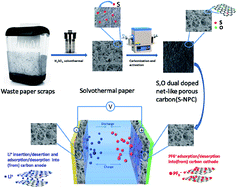S, O dual-doped porous carbon derived from activation of waste papers as electrodes for high performance lithium ion capacitors†
Abstract
To circumvent the imbalances of electrochemical kinetics and charge-storage capacity between Li+ ion battery anodes and capacitive cathodes in lithium-ion capacitors (LICs), dual carbon based LICs are constructed and investigated extensively. Herein, S, O dual-doped 3D net-like porous carbon (S-NPC) is prepared using waste paper as the carbon source through a facile solvothermal treatment and chemical activation. Benefiting from the combination effect of the rich S,O-doping (about 2.1 at% for S, and 9.0 at% for O), high surface area (2262 m2 g−1) and interconnected porous network structure, the S-NPC-40 material exhibits excellent electrochemical performance as both cathode material and anode material for LICs. S, O doping not only increases the pseudocapacity but also improves the electronic conductivity, which is beneficial to reduce the mismatch between the two electrodes. The S-NPC-40//S-NPC-40 LIC delivers high energy densities of 176.1 and 77.8 W h kg−1 at power densities of 400 and 20 kW kg−1, respectively, as well as superior cycling stability with 82% capacitance retention after 20 000 cycles at 2 A g−1. This research provides an efficient method to convert waste paper to porous carbon electrode materials for high performance LIC devices.



 Please wait while we load your content...
Please wait while we load your content...